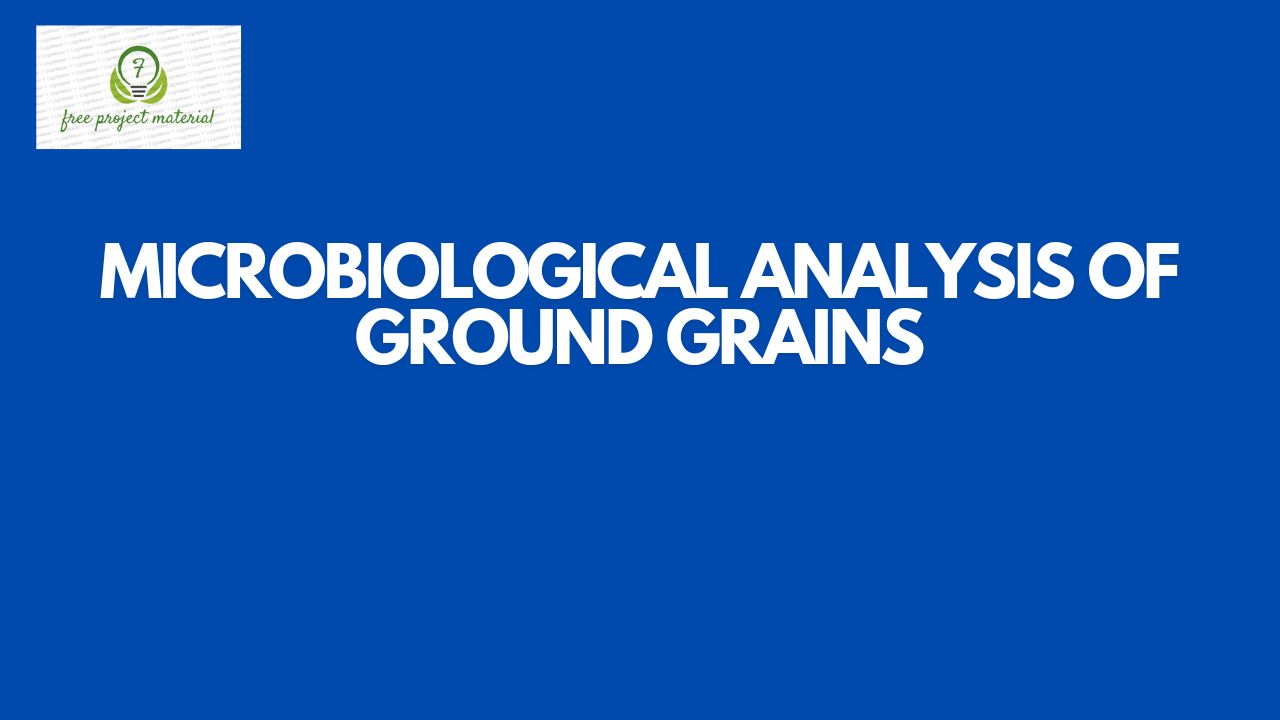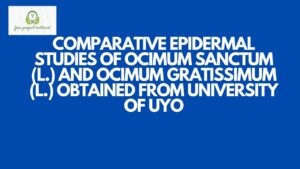ABSTRACT
The present study was conducted to assess the microbial contamination of grinded gains products sold in Otor Market in Ikot Ekpene L.GA. The sample collected were cultured on different media, the organism growing on the media were purified and identified using microbiological standards. The study revealed the heterotrophic bacterial count which ranged from 3.1×104 cfu/g to 6.2×104 cfu/g and fungi count which range from 0.9×104 cfu/g to 1.8×104 cfu/g. the organisms identified in this study include Staphylococcus sp, Lactobacillus sp, Streptococcus sp, Pediococcus sp, and Enterococcus sp. Bacillus sp, Aspergillus sp, Cladosporium sp, Penicillium sp and Fusarium sp. the organism isolated in this study could pose health risk to the consumers. Therefore, it is essential to reduce the contamination to the minimum to ensure safety both for human and animal consumption.
TABLE OF CONTENT
Title Page – – – – – – – – – i
Certification – – – – – – – – – ii
Dedication – – – – – – – – – iii
Acknowledgment – – – – – – – – iv
Abstract – – – – – – – – – v
Table of Content – – – – – – – – vi
CHAPTER ONE: INTRODUCTION
1.1 Background of the Study – – – – – – 1
1.2 Aim and Objectives of the Study – – – – 2
1.3 Scope and Limitation of the Study – – – – 3
1.4 Significance of the Study – – – – – – 3
CHAPTER TWO: LITERATURE REVIEW
2.1 Description of Grains – – – – – – 4
2.2 Classification of Grains – – – – – – 5
2.2.1 Cereal Grains – – – – – – – 5
2.2.2 Pseudocereal Grains – – – – – – 8
2.2.3 Pulses – – – – – – – – 8
2.2.4 Oil Seeds – – – – – – – – 9
2.3 Sources of Microbial Contamination of Cereal Grains – 10
2.4 Techniques for Control Microbial Spoilage of Cereal Grains – 13
2.5 Future Trends for Decontamination of Cereal Grains – – 15
2.6 Importance of Grains to Health – – – – – 16
2.7 Strategies to Migrate the Risk of Contamination for
Human Health – – – – – – – 17
2.8 Regulations in Food Safety – – – – – 18
2.9 Health Risk of Microbial Contamination of Wheat
Flour and Other Cereal Grains – – – – – 19
2.10 A Review of Microbial Contamination of Grains – – 20
CHAPTER THREE: MATERIALS AND METHOD
3.1 Materials – – – – – – – – 22
3.2 Sample Collection – – – – – – – 22
3.2.1 Sample Collection – – – – – – – 22
3.2.2 Sterilization of Glass wares and Media – – – 23
3.3 Microbiological Analysis – – – – – – 23
3.3.1 Sample Preparation/Serial Dilution – – – – 23
3.3.2 Cultivation of Microorganisms – – – – – 24
3.3.3 Enumeration of Bacterial Isolates – – – – 24
3.3.4 Purification of Bacterial Isolates – – – – 24
3.3.5 Characterization and Identification of Bacterial Isolates – 25
3.3.6 Characterization and Identification of Fungal Isolates – 25
CHAPTER FOUR: RESULTS AND DISCUSSION
4.1 Results – – – – – – – – 26
4.2 Discussion – – – – – – – – 33
CHAPTER FIVE: CONCLUSION AND RECOMMENDATIONS
5.1 Conclusion – – – – – – – – 36
5.2 Recommendations – – – – – – – 36
References
CHAPTER ONE: INTRODUCTION
1.1 Background of the Study
Development of agriculture in prehistoric times was heavily associated with domestication of cereal grains and since their first cultivation most civilizations have became dependent upon cereal for the majority of its food supply (Cordian, 1999). Cereal grains are the most commonly consumed food group worldwide and they are grown on about 60% of the cultivated land in the world (Koehler and Wieser, 2013). In order to meet the requirements of a growing world population , world wide production and yield of cereals has been increased for the last 50 years. Major types of cereals grains, include maize, rice and rye.
The secondary metabolites produced by fungi which can grow on grain (or mycotoxins) belongs to the most toxic contaminants occurring in a wide range of good commodities (Benneth and Klich, 2003). Some molds can potentially produce harmful mycotoxins and pose a serious health risk for consumers. Losses of cereal grains during storage are estimated between 5 and 30% due to molds and mycotoxins, 5% for insects and 2% for rodents, with an average yield loss of 1% for developed and 10% to 30% for developing countries. Depending on climatic conditions during growth, grains carry microbial load with a high diversity of potential spoilage organisms when harvested. In addition, post harvest contamination during transport is possible. This microbial load consists of bacteria, yeast, and filamentous fungi belonging to many different genera. The activity of these microorganisms during storage and accordingly, the shelf life of the crop is dependent on a range of factors. Amongst the most influential parameters are moisture content and water availability during storage as a result, grains are usually stored at low moisture contents of 12-13% and a wider activity of <0.7.
1.2 Aim of the study
The aim of this study is to examine the microbiological load of grinded grains in Otor Market.
The objectives of the study are;
- To investigate the bacterial contamination of grinded grains
- To determined the fungal load of grinded grains sold in Otor Market.
- To make useful recommendation base on the result of this findings.
1.3 Scope and Limitation of the Study
This study focuses only on the microbiological analysis of selected grinded grains sold in Otor market due to time and financial constraint.
1.4 Significance of the Study
- This study will be of importance to manufacturing companies as it will help to inform them of the health risk associated with cereal grains consumer so as to motivate them to step up microbiological screening of their products
- This study will also serves as reference materials to students and future researchers
- This study will help to intimate the public on the need to properly cooked cook grinded and non-grinded cereal grains before consumptions due to the risk of microbial contamination.


